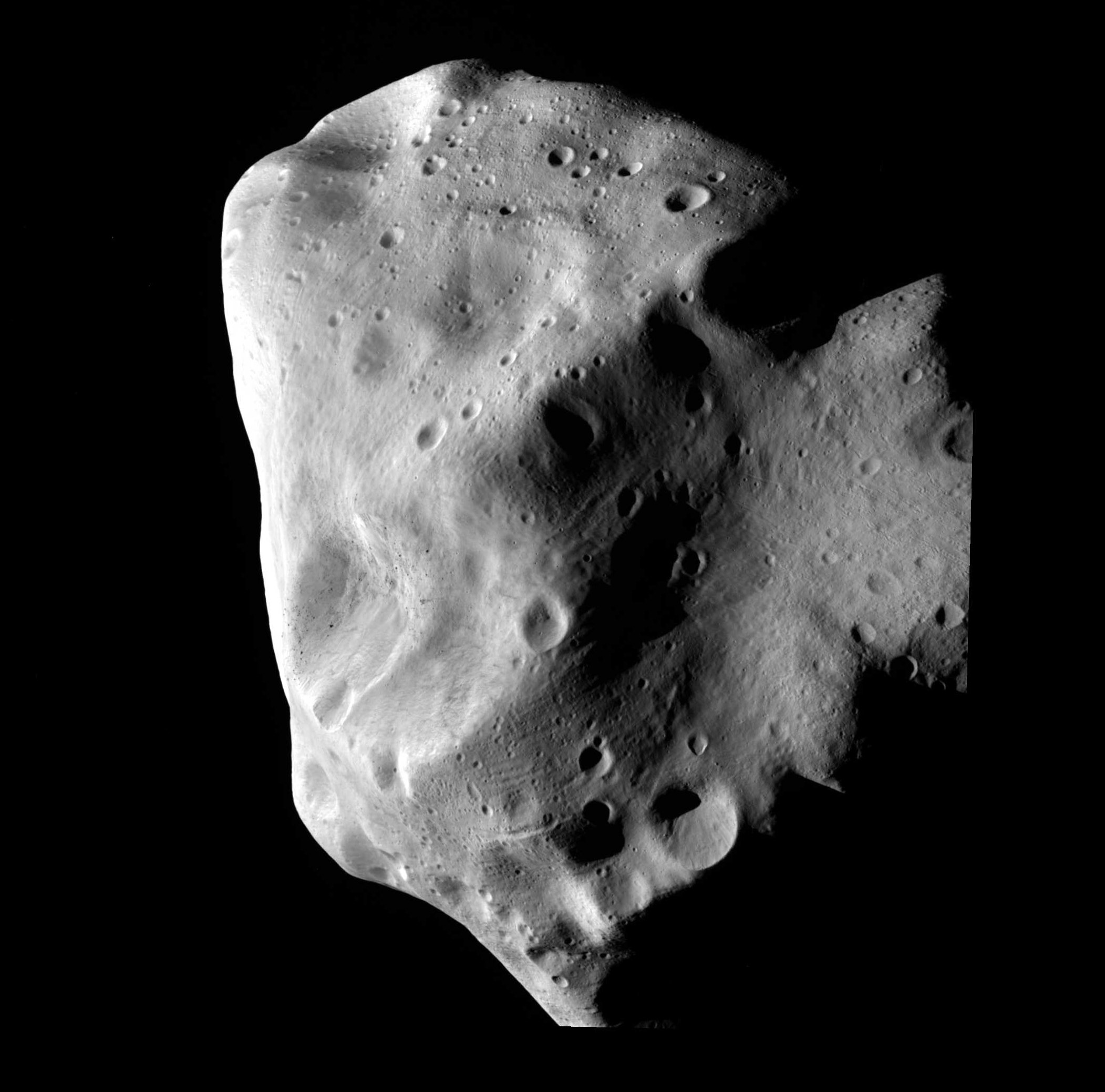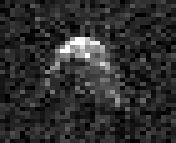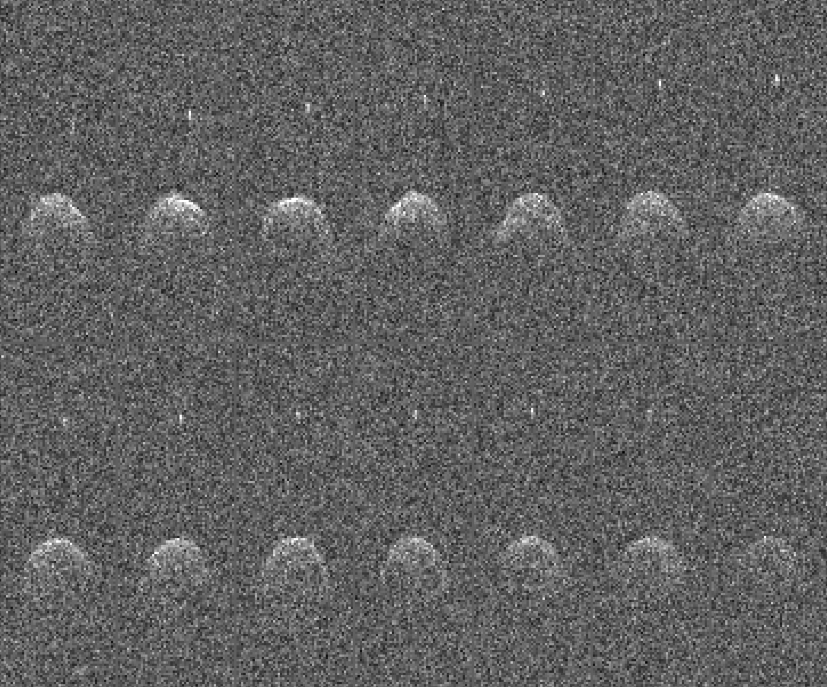|
(7474) 1992 TC
(7474) 1992 TC is a large sized M-type asteroid discovered by Robert H. McNaught in 1992. It is notably one of a few similar M-type asteroids, including the named asteroids 4660 Nereus and 65803 Didymos 65803 Didymos (provisional designation ) is a sub-kilometer asteroid and binary system that is classified as a potentially hazardous asteroid and near-Earth object of the Apollo group. The asteroid was discovered in 1996 by the Spacewatch surv ..., which can be reached easily by spacecraft from Earth. The delta-V required to reach 7474 (1992 TC) would be about , which is less than is needed to reach the Moon. M-type asteroids are thought to be composed primarily of nickel and iron, which if proven to be true means that 7474 (1992 TC) may one day become an important source of raw materials in space. With an absolute magnitude of 18.0, the asteroid is about 670–1500 meters in diameter. On 2031-Aug-11 the asteroid will pass from Mars. References External links ... [...More Info...] [...Related Items...] OR: [Wikipedia] [Google] [Baidu] |
Siding Spring Observatory
Siding Spring Observatory near Coonabarabran, New South Wales, Australia, part of the Research School of Astronomy & Astrophysics (RSAA) at the Australian National University (ANU), incorporates the Anglo-Australian Telescope along with a collection of other telescopes owned by the Australian National University, the University of New South Wales, and other institutions. The observatory is situated above sea level in the Warrumbungle National Park on Mount Woorat, also known as Siding Spring Mountain. Siding Spring Observatory is owned by the Australian National University (ANU) and is part of the Mount Stromlo and Siding Spring Observatories research school. More than 100 million worth of research equipment is located at the observatory. There are over 60 telescopes on site, though not all are operational. History The original Mount Stromlo Observatory was set up by the Commonwealth Government in 1924. After duty supplying optical components to the military in Worl ... [...More Info...] [...Related Items...] OR: [Wikipedia] [Google] [Baidu] |
Julian Day
The Julian day is the continuous count of days since the beginning of the Julian period, and is used primarily by astronomers, and in software for easily calculating elapsed days between two events (e.g. food production date and sell by date). The Julian period is a chronological interval of 7980 years; year 1 of the Julian Period was . The Julian calendar year is year of the current Julian Period. The next Julian Period begins in the year . Historians used the period to identify Julian calendar years within which an event occurred when no such year was given in the historical record, or when the year given by previous historians was incorrect. The Julian day number (JDN) is the integer assigned to a whole solar day in the Julian day count starting from noon Universal Time, with Julian day number 0 assigned to the day starting at noon on Monday, January 1, 4713 BC, proleptic Julian calendar (November 24, 4714 BC, in the proleptic Gregorian calendar), a date at ... [...More Info...] [...Related Items...] OR: [Wikipedia] [Google] [Baidu] |
Julian Year (astronomy)
In astronomy, a Julian year (symbol: a or aj) is a unit of measurement of time defined as exactly 365.25 days of SI seconds each.P. Kenneth Seidelmann, ed.''The explanatory supplement to the Astronomical Almanac'' (Mill Valley, Cal.: University Science Books, 1992), pp. 8, 696, 698–9, 704, 716, 730. Reprinted from the "IAU Style Manual" by G.A. Wilkinson, Comm. 5, in IAU Transactions XXB (1987).Harold Rabinowitz and Suzanne Vogel''The manual of scientific style''(Burlington, MA: Academic Press, 2009) 369. The length of the Julian year is the average length of the year in the Julian calendar that was used in Western societies until the adoption of the Gregorian Calendar, and from which the unit is named. Nevertheless, because astronomical Julian years are measuring duration rather than designating dates, this Julian year does not correspond to years in the Julian calendar or any other calendar. Nor does it correspond to the many other ways of defining a year. Usage Th ... [...More Info...] [...Related Items...] OR: [Wikipedia] [Google] [Baidu] |
Degree (angle)
A degree (in full, a degree of arc, arc degree, or arcdegree), usually denoted by ° (the degree symbol), is a measurement of a plane angle in which one full rotation is 360 degrees. It is not an SI unit—the SI unit of angular measure is the radian—but it is mentioned in the SI brochure as an accepted unit. Because a full rotation equals 2 radians, one degree is equivalent to radians. History The original motivation for choosing the degree as a unit of rotations and angles is unknown. One theory states that it is related to the fact that 360 is approximately the number of days in a year. Ancient astronomers noticed that the sun, which follows through the ecliptic path over the course of the year, seems to advance in its path by approximately one degree each day. Some ancient calendars, such as the Persian calendar and the Babylonian calendar, used 360 days for a year. The use of a calendar with 360 days may be related to the use of sexagesimal numbers. Anothe ... [...More Info...] [...Related Items...] OR: [Wikipedia] [Google] [Baidu] |
Asteroid Spectral Types
An asteroid spectral type is assigned to asteroids based on their emission spectrum, color, and sometimes albedo. These types are thought to correspond to an asteroid's surface composition. For small bodies that are not internally differentiated, the surface and internal compositions are presumably similar, while large bodies such as Ceres and Vesta are known to have internal structure. Over the years, there has been a number of surveys that resulted in a set of different taxonomic systems such as the Tholen, SMASS and Bus–DeMeo classifications. Taxonomic systems In 1975, astronomers Clark R. Chapman, David Morrison, and Ben Zellner developed a simple taxonomic system for asteroids based on color, albedo, and spectral shape. The three categories were labelled " C" for dark carbonaceous objects, " S" for stony (silicaceous) objects, and "U" for those that did not fit into either C or S. This basic division of asteroid spectra has since been expanded and clarified.Thomas ... [...More Info...] [...Related Items...] OR: [Wikipedia] [Google] [Baidu] |
M-type Asteroid
M-type (aka M-class) asteroids are a spectral class of asteroids which appear to contain higher concentrations of metal phases (e.g. iron-nickel) than other asteroid classes, and are widely thought to be the source of iron meteorites. Definition Asteroids are classified as M-type based upon their generally featureless and flat to red-sloped absorption spectra in the visible to near-infrared and their moderate optical albedo. Along with the spectrally similar E-type and P-type asteroids (both categories E and P were formerly type-M in older systems), they are included in the larger X-type asteroid group and are distinguishable only by optical albedo: : Characteristics Composition Although widely assumed to be metal-rich (the reason for use of "M" in the classification), the evidence for a high metal content in the M-type asteroids is only indirect, though highly plausible. Their spectra are similar to those of iron meteorites and enstatite chondrites, and radar observations h ... [...More Info...] [...Related Items...] OR: [Wikipedia] [Google] [Baidu] |
Robert H
The name Robert is an ancient Germanic given name, from Proto-Germanic "fame" and "bright" (''Hrōþiberhtaz''). Compare Old Dutch ''Robrecht'' and Old High German ''Hrodebert'' (a compound of '' Hruod'' ( non, Hróðr) "fame, glory, honour, praise, renown" and '' berht'' "bright, light, shining"). It is the second most frequently used given name of ancient Germanic origin. It is also in use as a surname. Another commonly used form of the name is Rupert. After becoming widely used in Continental Europe it entered England in its Old French form ''Robert'', where an Old English cognate form (''Hrēodbēorht'', ''Hrodberht'', ''Hrēodbēorð'', ''Hrœdbœrð'', ''Hrœdberð'', ''Hrōðberχtŕ'') had existed before the Norman Conquest. The feminine version is Roberta. The Italian, Portuguese, and Spanish form is Roberto. Robert is also a common name in many Germanic languages, including English, German, Dutch, Norwegian, Swedish, Scots, Danish, and Icelandic. It c ... [...More Info...] [...Related Items...] OR: [Wikipedia] [Google] [Baidu] |
4660 Nereus
4660 Nereus, provisional designation 1982 DB, is a small (about ) asteroid. It was discovered by Eleanor F. Helin on 28 February 1982, approximately a month after it passed from Earth. Nereus is potentially an important asteroid with a high albedo. It is an Apollo and Mars-crosser, with an orbit that frequently comes close to Earth, and because of this it is exceptionally accessible to spacecraft. Indeed, because of its small size and close orbit, its delta-V for rendezvous of ~5 km/s is smaller than the Moon's, which is about 6.3 km/s. Nereus makes seven approaches to Earth of less than 5 million km between 1900 and 2100. The closest will be on 14 February 2060, at 1.2 million km. The most recent closest approach was on 11 December 2021, when it was 3.9 million km away. During the 2021 approach, the asteroid peaked around apparent magnitude 12.6, requiring a telescope with around a 100mm objective lens to be visually seen. Its orbital period of 1.82 ... [...More Info...] [...Related Items...] OR: [Wikipedia] [Google] [Baidu] |
65803 Didymos
65803 Didymos (provisional designation ) is a sub-kilometer asteroid and binary system that is classified as a potentially hazardous asteroid and near-Earth object of the Apollo group. The asteroid was discovered in 1996 by the Spacewatch survey at Kitt Peak, and its small 160-meter minor-planet moon, named Dimorphos, was discovered in 2003. Due to its binary nature, the asteroid was then named ''Didymos'', the Greek word for 'twin'. Didymos's moon, Dimorphos, was the target of the DART mission to test the viability of asteroid impact avoidance by collision with a spacecraft, while the impact was witnessed by LICIACube, a flyby CubeSat component of the mission. Discovery Didymos was discovered on 11 April 1996 by the University of Arizona Steward Observatory's, and Lunar and Planetary Laboratory's, Spacewatch survey using its 0.9-meter telescope at Kitt Peak National Observatory in Arizona, United States. The binary nature of the asteroid was discovered by others; suspic ... [...More Info...] [...Related Items...] OR: [Wikipedia] [Google] [Baidu] |
Delta-V
Delta-''v'' (more known as " change in velocity"), symbolized as ∆''v'' and pronounced ''delta-vee'', as used in spacecraft flight dynamics, is a measure of the impulse per unit of spacecraft mass that is needed to perform a maneuver such as launching from or landing on a planet or moon, or an in-space orbital maneuver. It is a scalar that has the units of speed. As used in this context, it is not the same as the physical change in velocity of the vehicle. As a simple example, take a conventional rocket-propelled spacecraft which achieves thrust by burning fuel. The spacecraft's delta-''v'' is the change in velocity that spacecraft can achieve by burning its entire fuel load. Delta-''v'' is produced by reaction engines, such as rocket engines, and is proportional to the thrust per unit mass and the burn time. It is used to determine the mass of propellant required for the given maneuver through the Tsiolkovsky rocket equation. For multiple maneuvers, delta-''v'' ... [...More Info...] [...Related Items...] OR: [Wikipedia] [Google] [Baidu] |
Absolute Magnitude
Absolute magnitude () is a measure of the luminosity of a celestial object on an inverse logarithmic astronomical magnitude scale. An object's absolute magnitude is defined to be equal to the apparent magnitude that the object would have if it were viewed from a distance of exactly , without extinction (or dimming) of its light due to absorption by interstellar matter and cosmic dust. By hypothetically placing all objects at a standard reference distance from the observer, their luminosities can be directly compared among each other on a magnitude scale. As with all astronomical magnitudes, the absolute magnitude can be specified for different wavelength ranges corresponding to specified filter bands or passbands; for stars a commonly quoted absolute magnitude is the absolute visual magnitude, which uses the visual (V) band of the spectrum (in the UBV photometric system). Absolute magnitudes are denoted by a capital M, with a subscript representing the filter band used for mea ... [...More Info...] [...Related Items...] OR: [Wikipedia] [Google] [Baidu] |




